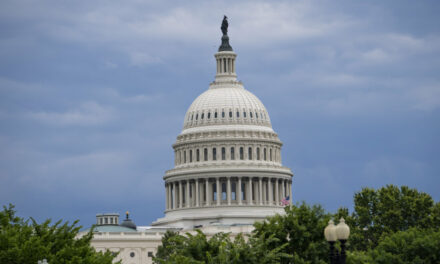We support our Publishers and Content Creators. You can view this story on their website by CLICKING HERE.
Cracking down on electronic cigarettes contaminated with illegal drugs is the DOJ’s ‘highest priority,’ according to Deputy Assistant Attorney General Arun Rao.
The U.S. Food and Drug Administration (FDA) has only approved 23 e-cigarette products, yet millions of illegal e-cigarettes have flooded the U.S. market, as stated at the Wednesday Senate Judiciary Committee hearing on youth vaping.
In July 2020, the U.S. Maryland District Court ordered the FDA to conduct a premarket review of all e-cigarette products by September 2021.
“That was 33 months ago—almost three years. FDA still has not completed its review,” Committee Chair Dick Durbin (D-Ill.) said in his opening statement.
Cracking down on electronic cigarettes (e-cigarettes) contaminated with illegal drugs is the Department of Justice’s (DOJ) “highest priority,” Deputy Assistant Attorney General Arun Rao said at the hearing.
Mr. Rao, who is of the consumer protection branch at the DOJ, made this statement in response to reports of youths suffering strokes and dying from unknowingly using vaping products laced with fentanyl and tetrahydrocannabinol (THC).
Illegal Vapes Flooding the US Market
E-cigarettes, or vapes, were initially intended to help smokers quit tobacco. However, young people have become hooked on the nicotine in these devices. Many e-cigarettes come in fruit flavors and bright packaging, enticing younger consumers.
Youths are particularly susceptible to nicotine addiction due to their underdeveloped brains, Dr. Susan Walley, a pediatrician and expert in tobacco and nicotine addiction at the American Academy of Pediatrics, said at the hearing.
Josie Shapiro, a high school girl who suffers from vaping-induced nicotine addiction, said that her addiction has harmed her physical and mental health.
Some youths have suffered severe lung injuries and lung failure from vaping, and others have been injured or killed by burns or explosions from cheap, unauthorized vaping devices.
The FDA has attempted to suppress youth vaping by banning all flavors except tobacco and conducting scientific reviews on e-cigarettes prior to authorizations.
Twenty-three e-cigarette products are currently authorized for the U.S. market. However, millions of unauthorized vapes are available illegally, easily accessible at any vape shop or convenience store.
Sen. Dick Durbin (D-Ill.), the chair of the U.S. Senate Committee, displayed a photo his staff took at a vape shop less than a mile’s radius from FDA headquarters in Maryland. The photo showed a shelf full of illegal vaping products, many of them with appealing fruit and soft drink flavors.
“Not a single one of these products has been authorized by the FDA, none of them. These illegal products are clearly designed for kids by their flavors, [and] are being sold in [the] FDA shadow of their building headquarters,” Mr. Durbin said.
While rampant illegal vaping products confer a public health risk, many believe their availability is also unfair to the companies selling their products legally.
David Spross, executive director of the National Association of Tobacco Outlets (NATO), said at the hearing that companies that want to legally market their products may wait four or five years to receive licensure.
The long wait times for licensure are due to the FDA’s increasing burden of e-cigarette applications. In response, Brian King, the FDA director for the Center for Tobacco Products, said that review applications have overloaded the FDA.
“FDA has received nearly 27 million premarket applications for e-cigarettes, which we are required by law to review,” Mr. King said at the hearing, adding that current regulation problems are due to the lack of “people and dollars.”
According to Mr. Durbin’s opening statement, the Maryland U.S. District Court ordered the FDA to perform a premarket review of all vaping products by September 2021. That deadline was pushed back, and the agency is now due to clear its backlog by June 30, 2024.
Mr. Durbin expressed concern and exasperation at the FDA’s delay, saying that the agency had 33 months to complete its review but still has not done so.
Major ‘Players’ Driving the Illegal Vape Market
Mr. Rao said that the players, or factors, in the illegal vape market are complicated and multifaceted.
One factor is that the tobacco industry supports vaping companies. Several of these vaping companies have received legal licensure for their products. All 23 authorized products are backed by big names in the tobacco industry.
In addition to this support, many of these companies chose to sell their products illegally while awaiting FDA approval.
Another main factor is vaping products coming across the border. China-owned e-cigarette companies make the vast majority of these products. While some may seek legal licensure and start selling their products before FDA authorization, many try to evade regulation and never seek FDA approval.
According to Mr. King, Chinese vaping brands are some of the most popular among U.S. youths. The first and second most popular brands are China-owned, while the third and fourth most popular are domestic.
Ranking committee member Sen. Thom Tillis (R-N.C.) asked if the FDA knew which player made up the bulk of the illegal vaping market so that the biggest problem could be addressed.
Mr. King responded that he could not make a “sweeping generalization.”
Smaller players within the market might include mom-and-pop manufacturers and retailers.
The committee members continuously questioned why the FDA would not pursue companies that started selling their products while awaiting approval.
The FDA did not answer this question.
The FDA’s premarket review requires that vaping manufacturers prove that their e-cigarettes have health benefits; therefore, the manufacturers, not the FDA, bear the burden of proof. Mr. Durbin commented that it seems the FDA is tasked with disproving the vaping companies’ assertions instead.
Mr. Rao said that the FDA and DOJ have penalized vaping companies and retailers to deter unregulated marketing of illegal products.
In his opening statement, Mr. King said that the agency had conducted thousands of inspections at the manufacturing level, resulting in nearly 900 warning letters to manufacturers and hundreds of warning letters to retailers.
According to Mr. King, the FDA has also worked with the DOJ to build cases supporting court orders against e-cigarette manufacturers and distributors, with eight complaints filed so far. The agency has also issued over 100 civil money penalties and conducted $18 million worth of e-cigarette seizures in conjunction with U.S. Customs and Border Protection.
However, committee members felt it was still unclear why the vaping market remains so poorly regulated.
Increased Law Enforcement Involvement
On Monday, the FDA announced it would form a task force with the DOJ and multiple law enforcement partners, including the Bureau of Alcohol, Tobacco, Firearms and Explosives, U.S. Marshals Service, U.S. Postal Inspection Service, and Federal Trade Commission, to combat the illegal distribution and sale of e-cigarettes.
“Unauthorized e-cigarettes and vaping products continue to jeopardize the health of Americans—particularly children and adolescents—across the country,” said Acting Associate Attorney General Benjamin C. Mizer in the press release.
“This interagency Task Force is dedicated to protecting Americans by combatting the unlawful sale and distribution of these products. And the establishment of this Task Force makes clear that vigorous enforcement of the tobacco laws is a government-wide priority.”
At the hearing, Tony Abboud, executive director of the Vapor Technology Association, argued that the FDA’s problem is not a lack of resources but regulatory interventions to control the market.
Committee member Sen. Richard Blumenthal (D-Conn.) disagreed, saying that regulation is always a matter of resources.

 Conservative
Conservative  Search
Search Trending
Trending Current News
Current News 







